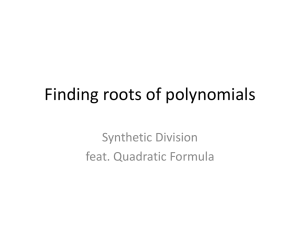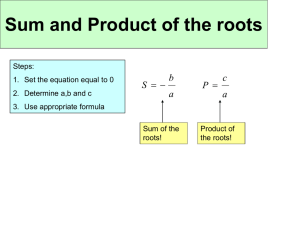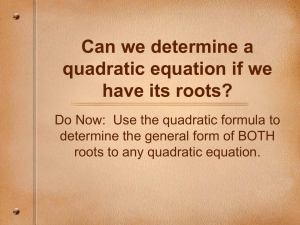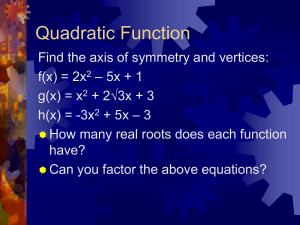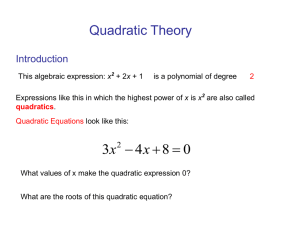FP1 identities and roots of equations lesson 9
advertisement
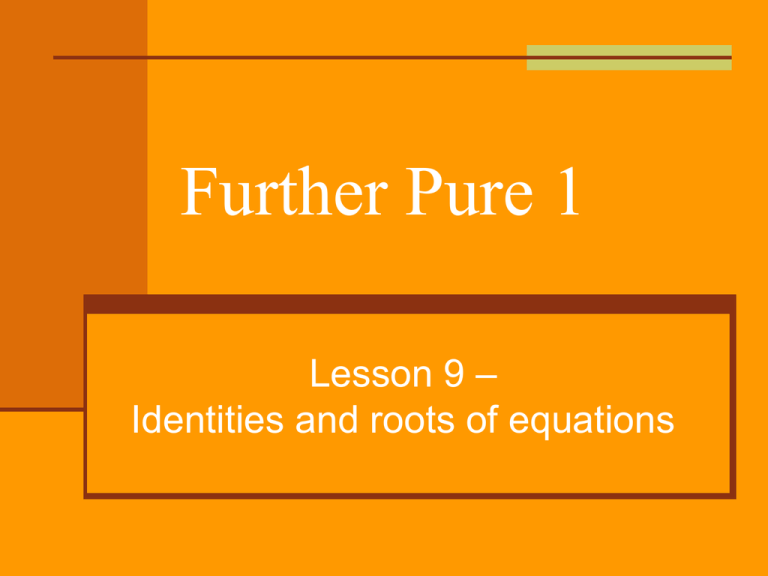
Further Pure 1 Lesson 9 – Identities and roots of equations Identities x3 – y3 Wiltshire (x-y)(x2 + xy + y2) is an example of an identity. The 3 lined equals sign means identically equal to. This means that both sides of the equation will always be equal whatever the values of x and y are. Here are some more examples of identities 2(x+3) 2x + 6 a2 – b2 (a+b)(a-b) In an identity all possible values of the variable(s) will satisfy the identity. With an equation only certain values satisfy the equation. Example : x2 – 5x + 6 = 0, only has two values that work, 2 & 3. What would happen if you tried to solve the identity (x+3)2 x2 + 6x + 9 Equating Co-efficient Wiltshire Sometimes you will be given an identity with unknown constants on one side, such as 3x2 + 11x + 18 (Ax – B)(x+5) + C There are two methods to finding out the values of these constants. Method 1 – Equating Coefficients Method 2 – Substituting in values Equating Coefficient + 11x + 18 Ax + 11x + 18 Ax Wiltshire 3x2 + 11x + 18 (Ax – B)(x+5) + C If you multiply out the right hand side you get 2 – 5Ax – Bx – 5B + C 3x2 2 – (5A – B)x – 5B + C 3x2 As both expressions are identically equal then we can equate the Coefficients. The terms in front of the x2 are equal so: A=3 The terms in front of the x will be equal so: 5A – B = 11 15 – B = 11 B=4 Finally the constants at the ends of both equations must be equal: -5B + C = 18 -20 + C = 18 C = 38 Now 3x2 + 11x + 18 (3x – 4)(x+5) + 38 Substituting in Values 3x2 + 11x + 18 Wiltshire (Ax – B)(x+5) + C Since the expressions are equal we can plug in any values we like for x to form equations in A,B and C that we can solve. Example if x = 1, then 3(1)2 + 11(1) + 18 = (A(1) – B)(1 + 5) + C 32 = 6A - 6B + C The problem is though that you now have one equation with 3 unknowns. When you pick your value of x to plug in try to pick values that will cancel out some of the unknowns. Substituting in Values Wiltshire 3x2 + 11x + 18 = (Ax – B)(x+5) + C If you pick x = -5 then all of the expression (Ax – B)(x+5) is equal to zero. So C = 75 - 55 + 18 = 38 Now if x = 0 then the A term will go and we are left with B and C, however we already know what C is. So 3(0) + 11(0) + 18 = (A(0) – B)(0 + 5) + C 18 = -5B + 38 -20 = -5B B=4 Finally we could use the example of x = 1 on the previous slide because we now know B & C. If x = 1, 32 = 6A – 6B + C 32 = 6A – 24 + 38 18 = 6A A=3 Note Identities are not always written using ``. Eg sin2θ + cos2θ = 1 Now do Ex 4A pg 100 Properties of the roots of polynomial equations Wiltshire In this chapter the variable x is replaced with a z to emphasize that the results could be complex or real. Solve each of the following quadratic equations a) x2 + 7x + 12 = 0 b) x2 – 5x + 6 = 0 c) x2 + x – 20 = 0 d) 2x2 – 5x – 3 = 0 Write down the sum of the roots and the product of the roots. Roots of polynomial equations are usually denoted by Greek letters. For a quadratic equation we use alpha (α) & beta (β) Properties of the roots of polynomial equations az2 + bz + c = 0 a(z - α)(z - β) = 0 a=0 This gives the identity az2 + bz + c = a(z - α)(z - β) Multiplying out az2 + bz + c = a(z2 – αz – βz + αβ) = az2 – aαz – aβz + aαβ = az2 – az(α + β) + aαβ Equating coefficients b = – a(α + β) c = aαβ -b/a = α + β c/a = αβ Wiltshire Task Wiltshire Use the quadratic formula to prove the results from the previous slide. -b/a = α + β b b 2 4ac 2a c/a = αβ b b 2 4ac 2a b b 2 4ac b b 2 4ac 2b b 2a 2a 2a a b b 2 4ac b b 2 4ac b 2 (b 2 4ac) 4ac c 2 2 2 a 2 a 4 a 4 a a Properties of the roots of polynomial equations Wiltshire Find a quadratic equation with roots 2 & -5 -b/a = α + β c/a = αβ -b/a = 2 + -5 c/a = -5 × 2 -b/a = -3 c/a = -10 Taking a = 1 gives b = 3 & c = -10 So z2 + 3z – 10 = 0 Note: There are infinitely many solutions to this problem. Taking a = 2 would lead to the equation 2z2 + 6z – 20 = 0 Taking a = 1 gives us the easiest solution. If b and c are fractions you might like to pick an appropriate value for a. Properties of the roots of polynomial equations Wiltshire The roots of the equation 3z2 – 10z – 8 = 0 are α & β 1 – Find the values of α + β and αβ. α + β = -b/a = 10/3 αβ = c/a = -8/3 2 – Find the quadratic equation with roots 3α and 3β. The sum of the new roots is 3α + 3β = 3(α + β) = 3 × 10/3 = 10 The product of the new roots is 9αβ = -24 From this we get that 10 = -b/a & -24 = c/a Taking a = 1 gives b = -10 & c = -24 So the equation is z2 – 10z – 24 = 0 Properties of the roots of polynomial equations Wiltshire 3 – Find the quadratic equation with roots α + 2 and β + 2 The sum of the new roots is α + β + 4 = 10/3 + 4 = 22/3 The product of the new roots is (α + 2)(β + 2) = αβ + 2α + 2β + 4 = αβ + 2(α + β) + 4 = -8/3 + 2(10/3) + 4 =8 So 22/3 = -b/a & 8 = c/a To get rid of the fraction let a = 3, so b = -22 & c = 24 The equation is 3z2 – 22z + 24 = 0 Properties of the roots of polynomial equations Wiltshire The roots of the equation z2 – 7z + 15 = 0 are α and β. Find the quadratic equation with roots α2 and β2 α+β=7 & αβ = 15 (α + β)2 = 49 & α2β2 = 225 α2 + 2αβ + β2 = 49 α2 + 30 + β2 = 49 α2 + β2 = 19 So the equation is z2 – 19z + 225 = 0 Now do Ex 4B pg 104


